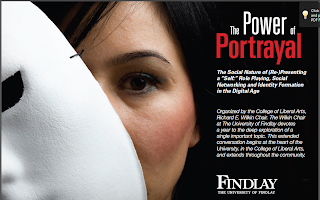I thought it made sense to place the print marketing materials up on the Power of Portrayal blog. If you haven't been to the UF campus recently and/or haven't received one of these in the mail, this is what they look like:
I suppose it's relevant to our theme to mention that the template in Blogger does not allow for PDF attachments, so I used a screen capture program to reconfigure these files and then upload them on the blog. This process reminded me of two relevant/related issues to considering how content is created/manipulated in digital environments in 2012:
1) Templates ("seamless" layered manifestations of what we now know as Web 2.0) cloak the struggles that early pioneers of the Internet faced when creating their digital spaces. In Web 1.0, bandwidth, technology and memory restrictions limited digital authors. Early web "autobiographers," e.g., Justin Allyn Hall (“Justin's Links from the Underground”) http://www.links.net/vita/ , used HTML encoded text to create their dynamic personal websites. These early Web 1.0 authors, by necessity, had a general knowledge of HTML code and an understanding of its limitations.
For example, imagine a web author like Hall writing his digital autobiography in January 1994 before web-design computer programs such as Adobe Dreamweaver were available. Hall decides that he wants a simple webpage—a header and three short sentences to appear on the computer monitor as follows:
Justin’s Self
Reflection
Justin is
bold
Justin
is big
Justin
is under and over
<html>
<body>
<h1>Justin’s
Self Reflection </h1>
<font
size=“2” face=“Times New Roman”>
<p><b>
Justin is bold</b></p>
<p><big>
Justin is big</big></p>
<font size=“2” face=“Times New Roman”>
<p>
Justin is<sub> subscript</sub> and
<sup>superscript</sup></p>
</body>
</html>
Since “WYSIWYG” (what you see is what you get) web-authoring
programs including Dreamweaver do not
exist in January 1994, everything Hall writes has to be manually coded. If he
wants just the words “Justin
is bold” on his webpage, he has to type “<html> <body>” to begin his
page, “<font size=“2” face=“Times New
Roman”>” to use 12 point, Time New Roman font, “<p><b> Justin is
bold</b></p>” to place the text in bold, and “</body>
</html>” to finish the page. In other words, all of the basic formatting functions
Web 2.0 authors assume are transparent and seamless were part of a laborious web
authoring process that acted to discourage the less committed and less
technologically savvy autobiographers.
The increasing
availability of Web 2.0 technological features after the year 2000, however, made
the process of web authoring much more user-friendly. These features provided
online autobiographers with an opportunity to circumvent coding in HTML if they
wished. Sophisticated web-design programs, Dreamweaver, etc., with their convenient screen
templates and relatively easy learning curves encouraged more people to
consider constructing their own pages because knowledge of HTML coding was no
longer a prerequisite skill. In some ways, these programs replicate the basic functions
of universally popular word processing programs like Microsoft Word allowing for a transfer of skills
from one well-known computer program (Word)
to a lesser-known computer program (Dreamweaver).
AND
2) To say I uploaded "print" marketing materials for the Power of Portrayal is a misnomer at best. The postcard above was born digital. The text was drafted in Microsoft Word, the photo was taken with a digital camera, and the design and layout was created in Adobe InDesign. The print product is now only a manifestation of the original digital process and finished product. This is not terribly profound in and of itself. We have been creating text and most other media through digital means for the better part of the last two decades. This technological progression (and let's be clear, this does not mean technological determinism), however, has in many ways disrupted not only the primacy and ethos of print as a privileged form of media, but it has also permanently changed what we expect from our media experiences on both the producing and consuming ends of the spectrum.
To give this a bit more perspective, in The
Gutenberg Galaxy (1962), Marshall McLuhan observed that every communication
medium or technology including alphabets, printing presses, and speech affects
the expression of thought through language. McLuhan’s protégé and eventual
critic, Walter Ong, noted in Orality and
Literacy (1982), the transformation from speech to writing that took place
several thousand years ago removed text from the world of sound and
“reconstituted the originally oral spoken word in visual space” (121). And the
shift from the handwritten manuscripts of the Middle Ages to the mechanically
produced printed books of the fifteenth century, meticulously detailed by
Elizabeth Eisenstein in The Printing
Press as an Agent of Change (1980), effected widespread cultural changes
including the preservation of knowledge, the accumulation of information, and
the widespread dissemination of ideas in a cheap and efficient manner.
Certainly, technological transformations of text are not new phenomena
exclusive to the current age of digital media. As language gravitated first
from the spoken word to crude stone tablets, from stone tablets to papyrus
scrolls, from papyrus scrolls to the handwritten codex, and eventually from
codex manuscript to the printed book, each successive “technologizing”[i]
of the word altered the relationship between the speaker (writer) and the
audience (reader). The migration of text from print to a digital format is the
latest of these textual transformations.


No comments:
Post a Comment